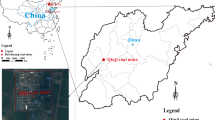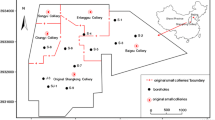Abstract
Mining of the No. 15 seam in the Gushuyuan coal mine is threatened by water inrush from the underlying Ordovician limestone aquifer. Water pressure and yield of the aquifer, the equivalent thickness of the water-resisting layer(s), and the properties of geologic structures are the major factors that control water inrush. The water inrush risk was evaluated using the vulnerability index (VI) method, which couples GIS with the analytic hierarchy process. Comparing the results with that of the traditional water inrush coefficient method in a specific mining area clearly showed the advantage of the VI method, especially in mines underlain by a thin water-resisting layer.
Zusammenfassung
Die Gewinnung des Flözes Nr. 15 in der Gushuyuan Kohlenmine wird durch Wassereinbrüche aus dem liegenden Ordovizischen Kalksteinaquifer bedroht. Die Hauptfaktoren, welche Wassereinbrüche kontrollieren, sind Wasserdruck und Ergiebigkeit des Aquifers, die äquivalente Mächtigkeit der wasserhemmenden Schicht(en) und die Eigenschaften geologischer Strukturen. Die Einschätzung des Wassereinbruchsrisikos erfolgte durch Berechnung einer Gefährdungsziffer (die vulnerability index [VI] Methode), welche GIS mit dem analytischen Hierarchieprozess (AHP) koppelt. Ein Vergleich der Resultate mit der konventionellen Methode der Bestimmung eines Wassereinbruchkoeffizienten in einem bestimmten Bergbaugebiet zeigte klar den Vorteil VI-Methode auf, besonders in Minen mit einem wenig mächtigen Geringleiter im Liegenden.
Resumen
La minería en la veta No. 15 en la mina de carbón Gushuyuan está amenazada por la irrupción de agua desde el acuífero suyacente de caliza Ordiviciano. La presión de agua y la extensión del acuífero, el espesor equivalente de la capa resistente de agua y las propiedades de las estructuras geológicas, son los factores más relevantes que controlan la irrupción de agua. El riesgo de irrupción fue evaluado usando el método del índice de vulnerabilidad (VI) que acopla GIS con el proceso analítico jerárquico (AHP). La comparación de los resultados con los obtenidos por el método tradicional de coeficiente de irrupción de agua en un área minera específica, muestra una clara ventaja del método VI, especialmente en minas debajo de las cuales subyace una delgada capa resistente de agua.
摘要
古书院煤矿15号煤开采受下伏奥陶系岩溶水突水威胁。含水层水压与水量、底板隔水层等效厚度、地质构造特征等是控制底板突水的重要因素。利用脆弱性指数法(VI)评价了古书院煤矿15煤底板突水危险性,脆弱性指数法(VI)是基于GIS技术与层次分析法(AHP)评价方法。脆弱性指数法(VI)与传统突水系数法的对比显示出脆弱性指数法的优点,脆弱性指数法(VI)尤其适于煤层下伏隔水层较薄条件下的底板突水危险性评价。






Similar content being viewed by others
References
Bukowski P (2011) Water hazard assessment in active shafts in Upper Silesian coal basin mines. Mine Water Environ 30:302–311
Li SC, Zhou ZQ, Li LP, Xu ZH, Zhang QQ, Shi SS (2013) Risk Assessment of water inrush in karst tunnels based on attribute synthetic evaluation system. Tunn Undergr Space Technol 38:50–58
Li LP, Lei T, Li SC, Zhang QQ, Xu ZH, Shi SS, Zhou ZQ (2015) Risk assessment of water inrush in karst tunnels and software development. Arab J Geosci 8:1843–1854
Meng ZP, Li GQ, Xie XT (2012) A geological assessment method of floor water inrush risk and its application. Eng Geol 143–144:51–60
Surinaidu L, Rao VVSG, Ramesh G (2013) Assessment of groundwater inflows into Kuteshwar limestone mines through flow modeling study, Madhya Pradesh, India. Arab J Geosci 6:1153–1161
Wang Y, Yang WF, Li M, Liu X (2012) Risk assessment of floor water inrush in coal mines based on secondary fuzzy comprehensive evaluation. Int J Rock Mech Min Sci 52:50–55
Wu Q, Dong SN, Zhang ZL (2007a) Mine water inrush disaster prevention and control. China Mining and Technology Univ Press, Xuzhou, pp 3–15
Wu Q, Xie SH, Pei ZJ, Ma JF (2007b) A new practical methodology of the coal floor water bursting evaluation III: the application of ANN Vulnerability Index method based on GIS. J China Coal Soc 32(12):1301–1306
Wu Q, Zhang ZL, Ma JF (2007c) A new practical methodology of the coal floor water bursting evaluation I: the master controlling index system construction. J China Coal Soc 32(1):42–47
Wu Q, Zhang ZL, Zhang SY, Ma JF (2007d) A new practical methodology of the coal floor water bursting evaluation II: the Vulnerability Index method. J China Coal Soc 32(11):1121–1126
Wu Q, Wang JH, Liu DH, Cui FP, Liu SQ (2009) A new practical methodology of the coal floor water bursting evaluation IV: the application of AHP vulnerability index method based on GIS. J China Coal Soc 34(2):233–238
Wu Q, Zhang B, Zhao WD (2013a) A new practical methodology of coal seam floor water burst evaluation V: the comparison study among ANN, the weight of evidence and the logistic regression vulnerability index method based on GIS. J China Coal Soc 38(1):21–26
Wu Q, Zhao SQ, Dong SN, Li JS (2013b) Handbook of mine water inrush prevention and control. Coal Industry Press, Beijing, pp 429–451
Xu SB (1998) Principle of analytic hierarchy process. Tianjin University Press, Tianjin, pp 45–60
Acknowledgments
This research was financially supported by the China National Natural Science Foundation (Grants 41430318, 51174289, and 41272276), China National Scientific and Technical Support Program (Grants 201105060-0 and 2012BAB12B03), National Engineering Research Center for Prevention and Control of Coal Mine Water Disasters (2014FU125Q06), National Geological Survey Program (shui[2012]-01-035-036), Fundamental Research Funds for the Central Universities (2010YD02), Innovation Research Team Program of Ministry of Education (IRT1085), and the State Key Laboratory of Coal Resources and Safe Mining. The authors also thank the editors and reviewers for their constructive suggestions.
Author information
Authors and Affiliations
Corresponding author
Electronic Supplementary Material
Below is the link to the electronic supplementary material.
Supplemental Fig. 1
Partition of mining area under water pressure of Ordovician limestone aquifer (PDF 145 kb)
Supplemental Fig. 2
Evaluation result based on water inrush coefficient for the No. 15 coal seam, (a) water inrush coefficient contour map and (b) partition map based on water inrush coefficient (PDF 153 kb)
Supplemental Fig. 3
Assessment results of the first working face #153302, (a) water pressure partition map, (b) Vulnerability Index evaluation partition map and (c) water inrush coefficient partition map (PDF 93 kb)
Rights and permissions
About this article
Cite this article
Wu, Q., Guo, X., Shen, J. et al. Risk Assessment of Water Inrush from Aquifers Underlying the Gushuyuan Coal Mine, China. Mine Water Environ 36, 96–103 (2017). https://doi.org/10.1007/s10230-016-0410-8
Received:
Accepted:
Published:
Issue Date:
DOI: https://doi.org/10.1007/s10230-016-0410-8




